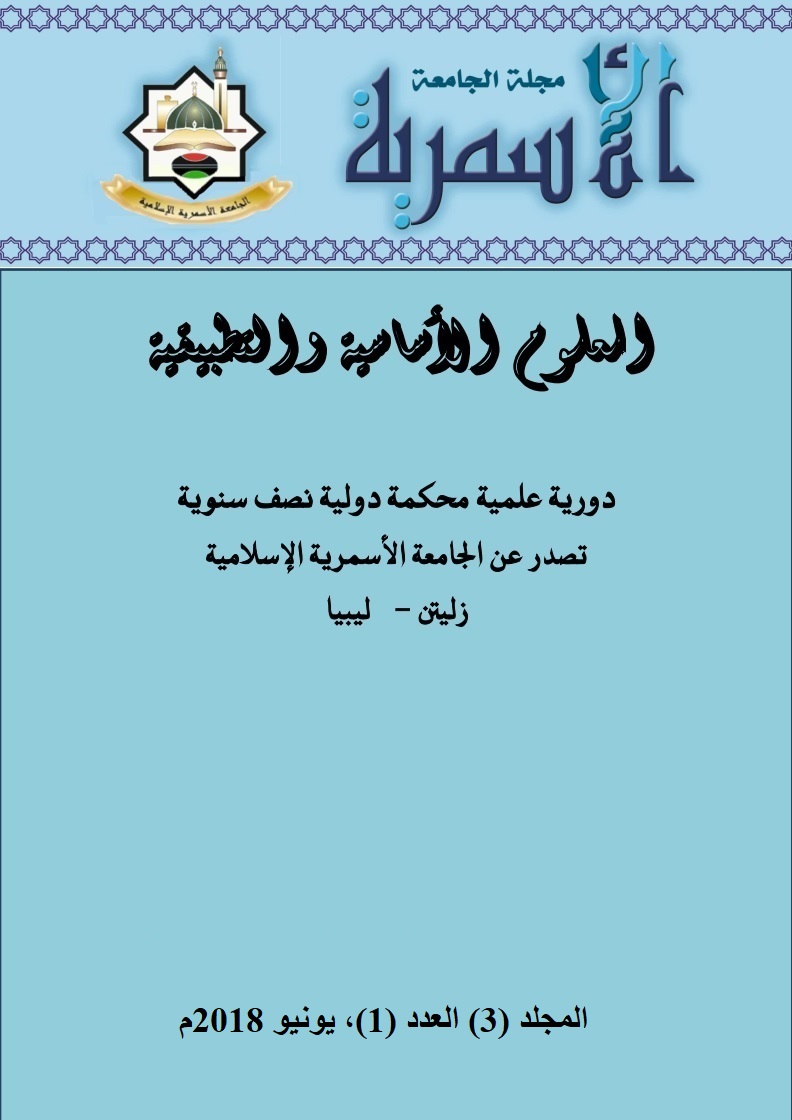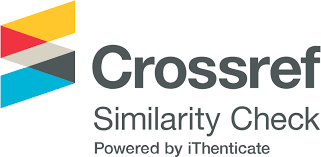Assessment of Microbial and Chemical Contamination in Re-Usable 18 Liter Bottled water Marketed in Tripoli City and its Suburbs
DOI:
https://doi.org/10.59743/aujas.v3i1.1615Keywords:
Microbial and chemical contamination, Bottle water, Tripoli City-LibyaAbstract
The increasing population and limited drinking water, resources have enhanced the necessity of using bottled water. Transmission of the waterborne disease is a major concern of public health, and it is important to know chemical and microbial contamination of bottled water. This study was to investigate the microbial and chemical contamination in 18liters refilled water samples consumed inTripoli city and its suburbs. 40 samples of bottled water were collected randomly from ten different brands. All the samples meet standard of the WHO guidelines. The mean values of nitrate, nitrite, turbidity, Na+, K+ and pH parameters were 7.10 mg/l, 0.013 mg/l , 0.36 NTU, 8.60 mg/l, 0.32 mg/l and 7.64, respectively. Results showed that the mean and standard devation of total coliforms bacteria were detected in 14.42% bottles water. The high levels of microbial faecal indicators recorded in this study indicate the possibility that pathogenic microorganisms and parasites might be present in the 18liters refilled bottles currently offered for sale at the local market. Such a situation might pose a threat to public health. Since the bottles are of the re-usable type, thus, the reasons behind the high levels of contamination of most brands of bottled water included in this study could be due to inefficient cleaning and sanitizing of the bottles before refilling, utilization of water from unsafe sources and inefficient sanitizing of water.
Downloads
References
Abed, K. and Alwakeel, S. (2007).Mineral and Microbial Contents of Bottled and Tap Water in Riyadh, Saudia Arabia, Middle -East J.Scientific Res.,2,151-156.
Ahmed, W., Yusuf, R., Hasan, I., Ashraf, W., Goonetilleke. A., Toze, S., and Road, B. (2013). Fecal indicators and bacterial pathogens in bottled water from Dhaka, Bangladesh. Brazilian Journal of Microbiology. 103(44), 97–103. DOI: https://doi.org/10.1590/S1517-83822013005000026
Alabdu, I. and Khan, M.(1995). Microbiological quality of bottled water in Saudi Arabia.J.Environ. Sci.Health,A30(10):2229-2241. DOI: https://doi.org/10.1080/10934529509376334
Alfraji K.M., Abd El Aleem M.K. and Al Ajmy H. (1999). Comparative study of potable and mineral waters available in the State of Kuwait. Desalination. 123,253-264. DOI: https://doi.org/10.1016/S0011-9164(99)00081-8
Bharath J., M., Motilal S., Sandy S., Sharma S., Tessaro T., Thomas K., Umamaheswaran M., Simeon D. and Adesiyun, A.(2003) Microbial quality of domestic and imported brands of bottled water in Trinidad.Int. J. Food Microbiol.81, 53-62. DOI: https://doi.org/10.1016/S0168-1605(02)00193-9
Crittenden J.C., Trussell R. R., Hand D.W., Howe K.J., Tchobanoglous G.(2012). Water Treatment: Principles and Design. 3th edition. John Wiley and Sons. DOI: https://doi.org/10.1002/9781118131473
Diduch M., Polkowska Z. , and Namiesnik J. (2013).Factors affecting the quality of bottled water. J. Expo. Sci. Environ. Epidemiol. 23, 111-119. DOI: https://doi.org/10.1038/jes.2012.101
Echoru, I., Ayikobua, E., Emorut, S. (2015). A Study to Investigate Major Community Health Challenges and Their Predisposing Factors in Bushenyi District of South Western Uganda. OJEPI. 81–88. DOI: https://doi.org/10.4236/ojepi.2015.52011
Ehlers, M., VanZyl, W., Pavlov, D. And Muller, E.(2004). A random survey of the microbial quality of bottled water in South Africa, Water SA., 30,203-210. DOI: https://doi.org/10.4314/wsa.v30i2.5065
Environmental Protection Agency, US (EPA). (2006). Overview of contaminations and their potential Health effects. Edition of the Drinking water standard and Health Advisors.
El-Abagy, M., Dutka, M., Kamel, M.and El-Zanfaly, H.(2000). Jncidence of Coliphage in Potable Water Supplies. Water Pollution Control Laboratory, National Research Centre, Cairo, Egypt, 79, 761-769.
Eric, D.B. and Isaac, K.F. (2013).Quality analysis of plastic sachet and bottled water brands produced or sold in kumasi Ghana. International Journal of Development and Sustainability.2(4),2222-2232.
Gleson, C. and Gray, N. (1997). The Coliform Index and Waterborne Disease. E and FN Spon, London, 194. DOI: https://doi.org/10.4324/9780203476888
Godini K., Sayehmiri K., Alyan G., Alavi S., Rostami R. (2012). Investigation of Microbial and Chemical Quality of Bottled Waters Distributed in Ilam western Iran (2009-10). Journal of Ilam University of Medical Sciences. 20, 33-37.
Guler C. (2007). Evaluation of maximum contaminant levels in Turkish bottled drinking waters utilizing parameters reported on manufacturer's labelling and government-issued production licenses. Journal of Food Composition and Analysis . 20, 262-272. DOI: https://doi.org/10.1016/j.jfca.2006.10.005
Hammer, J. and Hammer, M. (2007). Water and Wastewater Technology. Prentice Hall,6th Edition.
Hitchins, D., Feng, P., Watking, W., Rippey, S., and Chandler, L.(1998). Escherichia coli and the coliform bacteria.Chapter.4. In Food and Drug Administration Bacteriological Analytical Manual, 8th ed., AOA CInternational, Gaithersburg, MD.
Hunter, P. R. (1997). Waterborne Disease. Epidemiology and Ecology, John Wiley and Sons, Chichester, U K.
Jahed-Khaniki G.R., Mahdavi M., Ghasri A., Saeednia S. (2008). Investigation of nitrate concentrations in some bottled water available in Tehran.Iranian Journal of Health and Environment . 1, 45-50.
Leivadara S.V., Nikolaou A.D., Lekkas T.D. (2008). Determination of organic compounds in bottled waters. Food Chemistry. 108, 277-286. DOI: https://doi.org/10.1016/j.foodchem.2007.10.031
Liguori,G. , Cavallotti, I., Arnese, A., Amiranda, C., Anas-tasi, D., and Angelillo, I. F. (2010). Microbiological quality of drinking water from dispensers in Italy.BMC Microbiology.10, 1-5. DOI: https://doi.org/10.1186/1471-2180-10-19
Lisa, N., Peter N., Emmanuel, E., Isaac, E., and Josephat, M.(2015 ). Assessment of the microbiological quality of bottled water and protected spring water in Bushenyi district, Uganda. Scholars Academic Journal of Biosciences(SAJB).3(11), 896-900.
Isam, S. and Bahaa, N.(2010). Detection of Microbial and chemical contaminants of the plastic bottled drinking waters.J. Iraq market Res. .3(2),168-184.
Mellor, J., Smith, J., Samie, A., Dillingham, R.(2013). Coliform Sources and Mechanisms for Regrowth in Household Drinking Water in Limpopo, South Africa. Journal of Environmental Engineering, 139,1152 –1161. DOI: https://doi.org/10.1061/(ASCE)EE.1943-7870.0000722
Morton Hu., Mahler LW., and Bottled RL. (2011) Water: United States consumers and their perceptions of water quality. International Journal of Environmental Research and Public Health. 8,565–578. DOI: https://doi.org/10.3390/ijerph8020565
OECD. (2003). Assessing Microbial Safety of Drinking Water: Improving Approaches and Methods, IWA Publishing, Alliance House. London, UK.
Salvato J.A. (2003). Environmental Engineering and Sanitation. 3th edition. John Wiley & Sons.
Wardlaw GM, Hampl JS. Disilvestro RA. (2004). Perspectives in Nutrition. 6th ed. McGraw-Hill Publishers, New York, 372 – 412.
Williams S.P. (2001). Put the lid on bottled water. Newsweek.61, 34-38.
World Health Organization (WHO). (2003). Guidelines for Drinking-water Quality. 3rd Edition, Geneva, www.who.int/water_sanitation_health/S.
Zazouli M.A., Safarpour -Ghadi M., Veisi A. and Habibkhani P. (2013). Bacterial Contamination in Bottled Water and Drinking Water Distribution Network in Semnan, 2012.Journal of Mazandaran University of Medical Sciences.23, 62-70.
Downloads
Published
Issue
Section
License
Copyright (c) 2018 Journal of Alasmarya University

This work is licensed under a Creative Commons Attribution 4.0 International License.
The rights relate to the publication and distribution of research published in the Journal of Alasmarya University where authors who have published their articles in the Journal of Alasmarya University should Know how they can use or distribute their articles. They reserve all their rights to the published works, such as (but not limited to) the following rights:
- Copyright and other property rights related to the article, such as patent rights.
- Copyright on all open access article in Journal of Alasmarya published by Alasmarya Islamic University is retained by the author(s) and they can used in it's future works, including lectures and books, the right to reproduce articles for their own purposes, and the right to self-archive their articles..
- Authors grant Alasmarya Islamic University a license to publish the article and identify itself as the original publisher.
- Authors also grant any third party the right to use the article freely as long as its integrity is maintained and its original authors, citation details and publisher are identified.
The Creative Commons Attribution License 4.0 formalizes these and other terms and conditions of publishing articles











